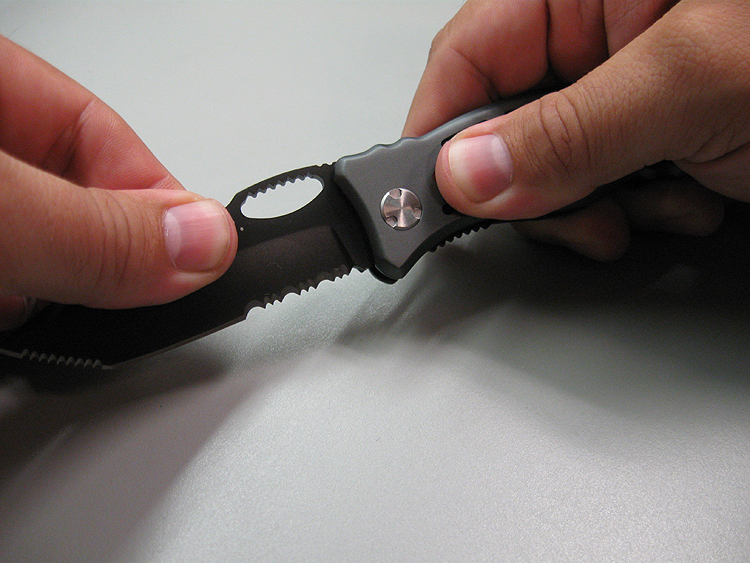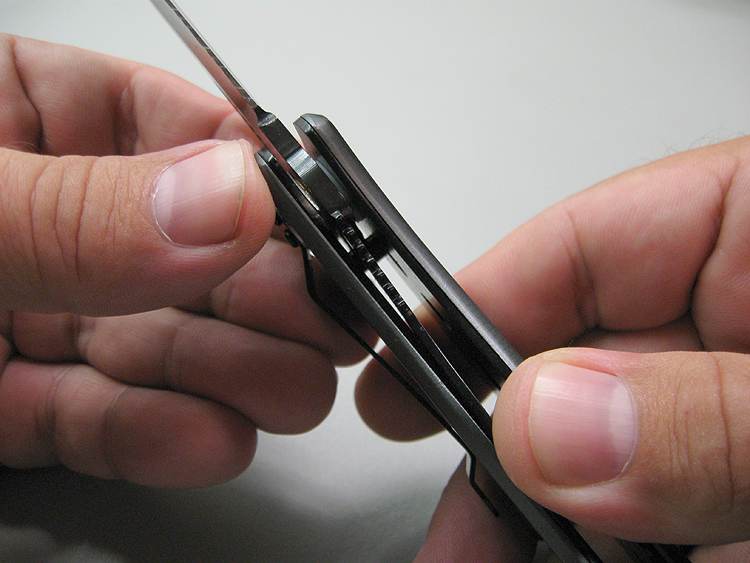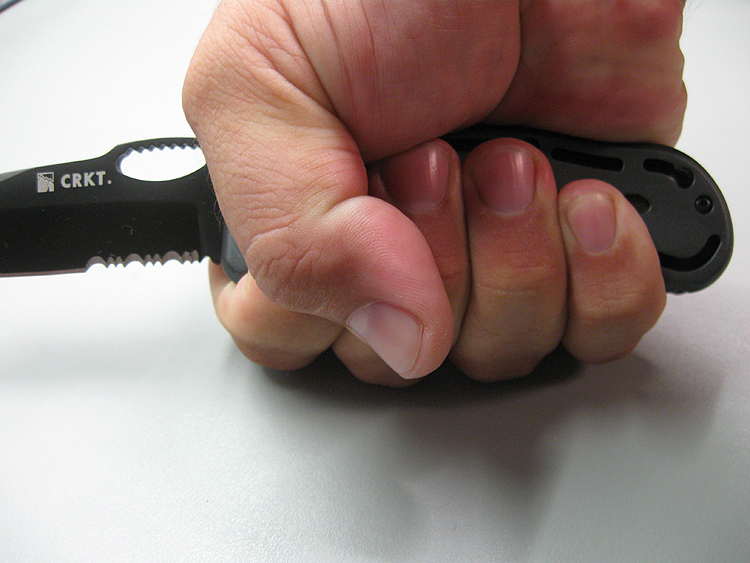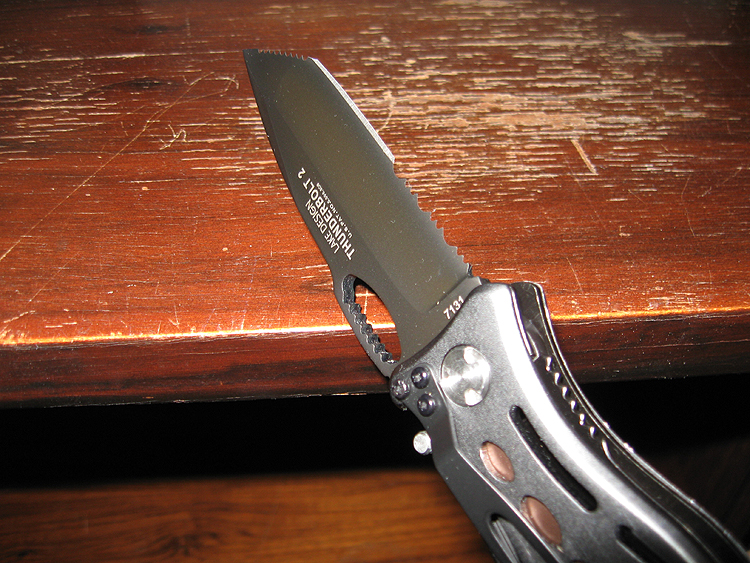If you carry a knife for utility or self-defense, you may choose a fixed blade or you may choose a folder. Debating which of these is “best,” preferable, or more suited to which applications could comprise a separate article. The assumption made in this article is that you are going to carry a folding knife, for whatever reason and within whatever restrictions. What you must acknowledge, then, is that your tool is “pre-broken.” Its lock mechanism is therefore only a temporary means of bracing the broken parts.
There are certain tests and evaluations you can conduct that will help you conclude, within reasonable parameters, that your folding knife’s lock is reliable. Remember, please, that these are tests that should be conducted periodically on hard-used knives, for lock wear over time (or damage incurred during use or by mishap) can change whether your knife passes or fails these tests. Buying quality helps when it comes to selecting a knife that won’t fail, but you can’t always buy your way to success. You get what you pay for… unless you get less. These tests aren’t guarantees; they are simply indicators of potential success or failure.
Visual and Audible Inspection
The first thing you do when you pick up any folding knife is look it over for fit and finish. Open and close it. See how the blade feels as it swivels. Is it gritty, or does it rotate smoothly? Does it lock open firmly and positively, or is the lock “soft” or even mushy as it engages? Look inside the parts of the knife that are visible when it is closed, when it is opened, and when the blade is only partly open. Look for wear, for cracks and fractures, and for anything that looks malformed or otherwise not right. In a rocker-bar locking folder, check to see if the finger of the locking bar engages properly in the slot in the blade tang, just forward of the pivot.
A well-made knife will “talk” to you as you operate it. With a little experience you will get the feel for a knife’s solidity, for the difference between excellent and poor fit and finish. Pay special attention, when you examine the knife, to the points where different materials mate or are otherwise joined, such as where handle insets meet the frame, where bolsters are affixed, where pins are set, etc. Whenever parts show gaps (where they aren’t flush) or where uncomfortable “hot” areas exist (where rough or sharp edges rub against your palm and fingers), there exists a problem in manufacture or assembly.
Check for Lateral and Vertical Blade Play
With the knife locked open, check to see how well the lock and the fit of the frame to the blade keep the blade in the locked-open position. Using a folded piece of cloth, cut-resistant gloves, or simply extreme care (so you don’t cut yourself), grasp the blade and the handle and see if the blade moves up and down or from side to side when locked in position.
Lateral blade play (side to side movement), if extreme, can indicate problems with fit and finish. A little lateral blade play is not unusual, especially in a knife with a plastic handle. Where metal rides against plastic (which is obviously more flexible than metal), lateral blade play is very hard to eliminate. Whether the handle or frame are plastic or metal, however, a lot of blade play (and yes, this is a subjective, relative measure that you’ll come to judge over time) indicates a very real problem with the knife’s assembly. A knife that exhibits a great deal of lateral play should be avoided.
Vertical blade play is an even bigger concern. Vertical blade play is usually caused by the failure of the knife’s locking mechanism to hold it firmly in the open position. What this means is that vertical play, unlike lateral play (which can be caused by the mating of different materials) is a direct result of sloppy fit in the blade lock itself. A very small amount of vertical play in a blade does not necessarily remove it from consideration for your use. Any more than that is a very serious concern. A knife that exhibits moderate vertical play should be avoided. (Properly made folding knives will exhibit no vertical play at all.)
Check Liner Lock Engagement
Knives with different proprietary locking mechanisms must be checked according to how their locking devices operate. We’ve discussed, in performing visual and audible inspections, how to check a rocker-bar locking folder. The liner lock, a popular design common on the knife market, presents a specific issue that must be checked regularly through the knife’s useful life.
Every liner lock is a springy piece of metal that moves into position to block the blade tang when the knife is opened. It rubs directly on the blade tang and thus will wear over the life of the folder. Properly made liner lock knives have a sloped blade tang that gets longer as the liner moves from left to right (on a right-handed liner lock). This is to maintain tension on the blade tang as the liner actually shrinks from grinding against the tang, growing slightly shorter.
A properly made liner lock should engage the blade tang fully, meaning it should not be sitting half on and half off the tang. It should engage the lock with some room for wear. Check the lock engagement periodically to make sure your liner lock hasn’t worn out yet. Be warned that if you use that knife for long enough, it will eventually become unsafe.
The Gorilla Grip Test
Once you’ve inspected your knife, checked the locking mechanism as applicable, and made sure any play in the blade is within acceptable limits, there are four tests you should perform. The first of these is the “gorilla grip” test.
The Boye Detent, when it was introduced, was a big deal. This is a scallop cut out of the lock release of rocker-bar locking folders. It was created specifically to help your folding knife pass the “gorilla grip” test, in recognition of your ability to release a knife accidentally by holding it.
With the knife locked open, grip as you would hold it in use. Grip it tightly and firmly. If your hand, your fingers, the swell of your palm — basically, any part of your body — is pushing against the lock release with significant force, this knife is not the correct knife for you. If you can accidentally trigger the lock release with your hand while tightly gripping the knife, the knife will be unsafe to use.
The Spine-Whack Test
The next test you should perform is a shock test. Holding the handle of the knife very carefully so that your fingers remain outside the blade channel, strike the spine of the knife against a hard wooden surface. Wood is a good choice because it won’t damage the finish of your blade, but it is hard enough to provide sufficient resistance. A folding knife that has a nice, strong lock will pass the spine whack test. A folding knife with a weak lock will disengage when the spine is struck against a hard object.
Blade Torque Test
Because the spine whack isn’t a realistic simulation of the forces a knife blade will experience in use, the third test you should perform is a blade torque test. Using something like a folded square of cloth to protect your fingers, carefully grasp the blade and handle (with the knife locked open). Twist the knife blade forward and back as if you are wringing a towel. A well-made folding knife should not disengage when torqued in this fashion.
Draw, Deploy, Apply, Replace
The final test you should perform, before relying on a folding knife for utility and defense, is a “use” test. It’s fine to make sure the component functions of a folding knife are operating properly, but you need to know if these discrete operations come together to form an integrated whole. You should carry the knife as you intend to carry it and, from this position it, draw it, open it, cut something with it (it doesn’t matter that much just what you choose), and then replace the knife in its carry spot.
It is in conducting this test that you will learn what doesn’t work — something you can’t predict and haven’t anticipated. If drawing the knife naturally causes it to hang up, if the opening simply isn’t comfortable when you’ve grabbed the knife from your pocket, if some factor you just didn’t consider now makes itself known… the practical draw, deploy, apply replace progression will reveal this. Only when you’ve tested the knife to make sure it works in practice as it is supposed to work in theory should you walk out the door believing you can depend on it.
Conclusion
A folding knife, because it has moving parts, is by definition a mechanism that could fail. For that matter, even a fixed blade can fail under the right circumstances, especially if it is abused. Setting aside issues created by knives that are improperly manufactured, there is always a certain element of risk whenever you take up any tool and then use it for any task.
While there is no universal standard by which a knife can be judged, it should, at the very least, perform as it has been advertised to perform. That seems a common-sense guideline to me. Despite the best intentions of both seller and buyer, however, that ancient dictum, caveat emptor, applies. Even if you buy what you believe to be a high-quality knife, you cannot know with any real degree of certainty that it will function as it is supposed to.
Fielding a piece of gear always entails risk. What this article describes is the minimum you should do before choosing to carry a folder. The tests outlined herein will help give you some greater measure of confidence in the tool you choose. Only in practical application will your best guess be proven out, which is why it is so important that your best guess also be an educated one.




another wonderful article. Learning how to use and care for a knife was a right of passage for me as a young boy. My grandfather gave me an “old Timer’ pocketknife, and i was expected to know how to clean, maintain, and safely use it BEFORE i could ever think about carrying it. I think a lot of people skip the basics, and for that reason, they never learn the respect that these tools should be given.
Hey Phil, this is a very informative article. These can be an accident waiting to happen if you don’t understand the fundamental properties of a folding knife.
I live in Vietnam, “I just wanted to say I really like the information strictly honest, objective I read your article about The Pocket-Sized Urban Encounter Kit and” Diplomat “Tactical Pant for now, I still the Spec Ops tHE wallet wallet I do not know what else to say things I pray the peace of luck to Phil Elmore Thank you and Bless You.
Good thoughts. I’m sure you’re aware, but Hank Reinhardt, Masad Ayoob, and Micheal Janich all have good stuff on various subjects involved with use of knives for self defense. I carry a ZT0300 which I am totally impressed with. I consider it a “very short sword” to maintain the correct attitude because it’s easy to fall into considering it a “neat toy/tool” and therefore lose one’s mental edge and ability to use it effectively in a violent confrontation.